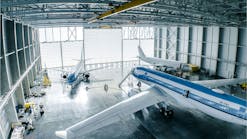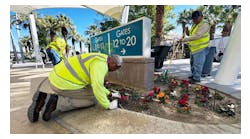Tools of the Trade
Keep ’em safe to keep ’em flying
By Fred Workley October 2001
Have you ever taken the time to read all the fine print on the placards on the tools and equipment that you may use every day? Look around and note the number of pieces of equipment in your shop with big caution signs and a lot of small print. Most equipment manufacturers are very concerned about the safety of their products. Why are they more than willing to provide advice and engineering information to ensure safe operation of their equipment? They want to keep their customers and potential customers safe. They also want to minimize their liability should any adverse legal action arise.
Everyone should be knowledgeable of the equipment and tools they are using as well as the hazards that are present and how to control these hazards. No person should undertake a job that is unsafe. It must be common practice to have all mechanical safeguards in place. Appropriate safety glasses, face shields, gloves, etc., must be used while working with hand tools or equipment that might produce flying material.
Hand tools and hand-operated equipment
Some questions to consider when using hand tools and hand-operated equipment include:
• Are all tools and equipment in good condition?
• Do you know the possible hazards that are caused by faulty or improper use of hand tools?
• Are hand tools such as chisels, punches, etc., which develop mushroomed heads during use, replaced or reconditioned as necessary?
• Are broken or fractured handles on hammers, axes and similar equipment promptly replaced?
• Are cutting edges kept sharp so that tools will move smoothly without binding or skipping?
• Are tools in a dry and secure location where they are kept clean and accounted for?
Portable, power-operated tools and equipment
• Are power tools used with the correct shield, guard, or attachment as recommended by the manufacturer?
• Are portable circular saws equipped with guards above and below the shoe and are the guards checked to assure that they do not wedge up thus leaving the lower portion of the blade unguarded?
• Are rotating or moving parts of equipment guarded to prevent physical contact?
• Are guards in place over belts, pulleys, chains, and sprockets on equipment such as air compressors?
• Are all cord-connected, electrically operated tools and equipment effectively grounded or have at least approved double insulated construction?
• Is hoisting equipment marked with weight ratings and inspected periodically?
• Are ground-fault circuit interrupters used on all temporary electrical circuits over 15 to 20 amps?
• Are hydraulic and pneumatic hoses on power equipment checked often for damage and deterioration?
• Do you always take the time to unplug the pneumatic drill or electric drill before you remove or replace a drill in a drill chuck?
"Power-actuated tool in use"
Power actuated tools are of special concern. Are you trained to use power-actuated tools? In some states, certain power-actuated tools require a valid operators card. Is each power-activated tool stored in its own lockable container when not in use? Some work areas require a conspicuous sign of least seven by ten inches in boldface lettering saying "POWER-ACTUATED TOOL IN USE" be posted while the tool is being operated. These power-actuated tools must be left unloaded until they are actually ready to be used. Do you inspect these tools daily for defects or obstructions? Do all power-actuated tool operators use appropriate personal protective equipment such as hearing protection, safety goggles, hard hats and safety shoes?
Machine or equipment guards
Another category of concerns is associated with machine or equipment guarding.
• Have you been instructed on the safe methods of operating a machine or piece of equipment?
• Do you provide adequate supervision to others?
• Is machinery and equipment given safety inspections along with being properly maintained and cleaned?
• Does the work area around machines permit set up and servicing as well as material handling and waste removal?
• Is machinery and equipment properly anchored or secured?
• Can you reach the power cut off switch?
• Ensured that non-current–carrying, metal parts of electrically-operated machines are grounded or have bonding straps installed?
• Are all emergency stop buttons colored red?
• Are foot-operated switches arranged to prevent accidental actuation by personnel or falling objects?
• Are manually-operated switches and valves controlling the operation of equipment and machines clearly identified and readily accessible?
• Are machinery guards secure and logically placed so that they don’t pose a hazard themselves?
Other considerations
• Are revolving drums, barrels, and containers, guarded by an enclosure that is interlocked with the drive mechanism guarded so that revolution cannot occur unless the guard enclosure is in place?
• Do arbors and mandrels have firm and secure bearings and are they free of play?
• If a machine is operated or cleaned with compressed air, is the air pressure regulated and is personal protective equipment or other safeguards utilized to protect you from eye and body injury?
• Are saws used for ripping, equipped with anti-kickback devices and spreaders?
• Are radial arm saws arranged so that the cutting head will return to the back of the table when released?
Lock-out, block-outprocedures
The last thing you need to review is Lock-Out, Block-Out procedures. Equipment and machines should not automatically start when power is restored after a power failure or shutdown. Always ask if electric power to each machine be locked out for maintenance, repair or security. All equipment and machinery that is capable of movement is required to be de-energized and blocked or locked-out during cleaning, servicing, adjusting or set up. Where the power disconnecting means for equipment does not also disconnect the electrical control circuit, then a separate means to deactivate the control circuit must be provided with a mechanical disconnect or lock-out. In some codes, locking out of control circuits in lieu of locking-out main power disconnects is prohibited. Are all equipment valve handles provided with a means for locking-out? Do your procedures require any stored energy either mechanical, air pressure or hydraulic pressure to be released before equipment is locked-out?
More helpful tips
It is accepted as good practice for the person exposed to the hazard to place and to remove safety locks. When you perform the lock-out block-out procedures are you provided with individually keyed safety locks that you keep personal control over? Is there a means of identifying the person who is working on the locked-out equipment? Are there enough accident prevention signs as well as tags and safety padlocks to cover all situations? Is it required that you check the safety lock-out by attempting to start up after making sure here is no danger? Have you been instructed to always push the control circuit stop button prior to re-energizing the main power switch? When equipment or machine operations require you to leave your control station is every function that could accidentally be activated locked or blocked-out? In the event the certain equipment or lines cannot be shut down, tagged or locked-out do you have a safe job procedure established and do you follow it?
As we have seen, you have a lot to think about when you are using tools, equipment and machinery. The tools of our trade make us money, but they can also cost us money if their use leads to time loss or an injury. Safe use of tools in aircraft maintenance assures that we can Keep ’em Flying.





